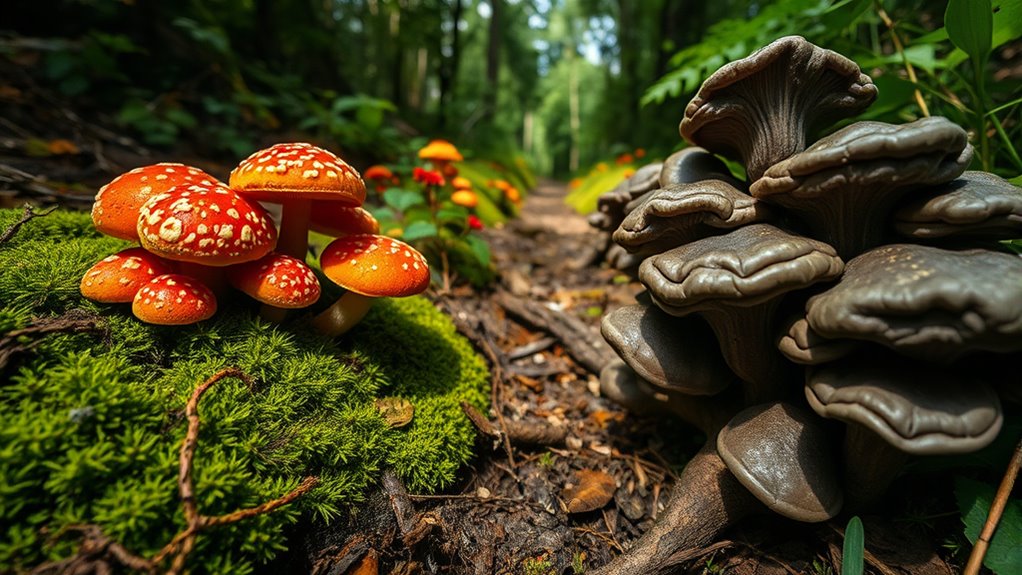On the trail, watch for mushrooms with white or pale, sticky caps and bulbous bases called volvas, as these can signal deadly toxins like Amanitas. Bright colors such as reds, yellows, and oranges can also indicate danger, but don’t rely solely on color—look for features like a ring (annulus) around the stem or gum-like gills underneath. Recognizing these signs can help protect your dog from poisoning; keep exploring to learn more about safe and risky fungi.
Key Takeaways
- Identify toxic mushrooms by white or pale sticky caps, bulbous base (volva), and distinctive features like rings (annulus).
- Avoid mushrooms with bright colors such as red, yellow, or orange, which can signal toxicity.
- Prevent dogs from consuming wild fungi by supervising closely and recognizing dangerous mushroom traits.
- Use visual cues like gills (white or free) and cap shape over smell or feel for safer identification.
- When uncertain, do not allow your dog to eat any wild mushroom and consult a professional for guidance.

Many dog owners may not realize that while some mushrooms are harmless, others can be highly toxic to your furry friend. When you’re out on the trail, it’s easy for your dog to stumble upon wild fungi, but knowing which varieties pose a danger isn’t always straightforward. Poisonous varieties often look similar to edible mushrooms, making identification tricky. That’s why it’s essential to learn some identification tips to keep your dog safe during outdoor adventures.
First, understand that many toxic mushrooms have certain features that can help you distinguish them. For example, some poisonous types, like the deadly Amanita species, often have a conspicuous white or pale cap with a sticky surface and a prominent, bulbous base called a volva. Others, such as the Death Cap, may look innocuous with a greenish or yellowish hue but are highly toxic. Poisonous varieties also sometimes have a foul smell or a slimy texture, but don’t rely solely on smell or feel—visual cues are more dependable.
Many toxic mushrooms have distinctive features like a white or pale cap with a sticky surface and bulbous base.
Identification tips include checking the gills underneath the cap; many toxic mushrooms have white, free, or crowded gills that don’t attach to the stalk. The stalk itself may feature a ring or skirt, known as an annulus, which can serve as a warning sign. Be cautious of mushrooms with bright colors—reds, yellows, or oranges—although some edible species share these colors. A key tip is to avoid mushrooms with a universal cap that looks like a typical button mushroom, as many toxic ones mimic this appearance. Additionally, some toxic mushrooms exhibit distinctive coloration patterns that can aid in identification.
Always remember that if you’re unsure about a mushroom’s safety, it’s best to err on the side of caution. Never let your dog eat wild fungi, even if they seem curious or you think it looks edible. Many accidental poisonings happen because owners can’t accurately identify fungi in the wild. Keep a close eye on your dog while hiking, especially in wooded areas where mushrooms thrive. Use a reliable mushroom identification guide or app if you’re interested in learning more, but don’t rely solely on these tools in the field—they aren’t foolproof.
Frequently Asked Questions
Can Dogs Develop Allergies to Certain Mushrooms?
You might wonder if dogs can develop mushroom allergies, and yes, they can. Some dogs experience allergic reactions to certain mushrooms, leading to symptoms like itching, swelling, or stomach upset. It’s important to watch for signs of mushroom allergies, especially if your dog has a history of food allergies. If you notice any unusual reactions after your dog encounters mushrooms, consult your vet promptly to prevent serious allergic reactions.
What Immediate Steps Should I Take if My Dog Ingests a Mushroom?
If you suspect your dog has ingested a mushroom, act quickly. First, prevent further ingestion by removing your dog from the area. Then, seek immediate veterinary care and provide information on mushroom identification if possible. During the wait, you can perform emergency first aid by keeping your dog calm and monitoring for symptoms like vomiting or weakness. Prompt action can be lifesaving in mushroom poisoning cases.
Are There Any Home Remedies for Mushroom Poisoning in Dogs?
Thinking about home remedies for mushroom poisoning? Irony strikes—natural treatments might sound tempting, but they’re often not safe or effective. If your dog ingests a mushroom, don’t rely on home remedies. Instead, contact your vet immediately. They can provide proper treatment, whether it’s induced vomiting or other medical interventions. Remember, when it comes to mushroom poisoning, professional care beats DIY solutions every time.
How Can I Identify Mushrooms That Are Toxic to Dogs?
To identify mushrooms that are toxic to dogs, focus on visual identification and their typical mushroom habitat. Look for mushrooms with bright colors, unusual shapes, or a foul odor, as these can be signs of toxicity. Keep in mind that many toxic mushrooms grow in woodland or grassy areas. Always supervise your dog on trails, and if you suspect ingestion, contact your vet immediately, as visual cues alone aren’t always reliable.
Are There Breed-Specific Risks Related to Mushroom Toxicity?
They say “an ounce of prevention is worth a pound of cure,” and that’s true for mushroom risks. Breed sensitivities and size considerations matter; smaller breeds may experience more severe reactions, and some breeds are more prone to toxicity. Always supervise your dog on trails, especially if they’re a breed with known sensitivities. Knowing your dog’s breed and size helps you act quickly if they nibble a questionable mushroom.
Conclusion
Remember, about 50% of all mushroom species are toxic to dogs, making identification essential. Always keep an eye on your furry friend during outdoor adventures, as quick ingestion can lead to serious health issues. Educate yourself on the most common safe and dangerous varieties, and when in doubt, consult your vet immediately. Staying vigilant can mean the difference between a fun hike and a trip to the emergency vet—so stay informed and cautious on the trail.










